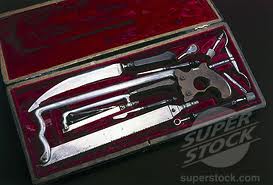Skeletons reveal sailors’ grisly deaths  (from Maritime Great Britain)
(from Maritime Great Britain)
Based on recent studies done on skeletons exhumed from three naval graveyards in Britain it was determined that roughly 6 percent of sailors who died in naval hospitals succumbed as a result of botched amputations or from complications secondary to amputations. No wonder Patricia (posing as Patrick MacPherson, surgeon’s mate of His Majesty’s frigate Richmond) is worried about amputating Everett Lee’s leg aboard a tossing ship! 

My fascination with 18th century amputations and other surgical procedures has led me to museums to view 18th century surgical instruments first hand, as well as to YouTube videos of amputations. (Caution! Not for the squeamish! Although I have over a decade experience as a Registered Nurse, mostly in the Critical Care and Emergency setting, I found these videos unnerving!) Now, consider the poor sailor undergoing an amputation before the age of modern anesthesia and electric bone saws! Imagine being conscious, your senses dulled only by laudenum or liquor, and held down by restraints or human hands while the surgeon cut off the offending extremity as quickly as possible.
As imperfect as 21st century medicine is, care today is light years ahead of 18th century medical and surgical interventions. Many times we know the best way to treat an injury or illness and we have reduced mortality rates to nearly zero for many surgical procedures. It is assuring that all members of our society have affordable access to state-of-the-art healthcare that is the problem in early 21st century America…
Aboard an 18th century British naval vessel, as on land, the patients were at the mercy of the surgeon and his mates. Some of the techniques and much of the medicine was not helpful at all. Bloodletting, for example. What were they thinking? How many times did excessive bloodletting hasten someone’s death? Yet amputations done skillfully could save lives, and probably did save many.
Before writing the amputation scene in Surgeon’s Mate, I read as many accounts as I could find by naval surgeons of the era. Using my knowledge of anatomy, physiology, psychology, and nursing care, I tried to imagine what it would be like to cut someone’s leg off aboard a tossing ship. I watched several YouTube videos of live amputations, to see how quickly an amputation takes using modern instruments, including an electric bone saw, with the patient made oblivious through the miracles of modern chemistry. Then I wrote the scene in which Patricia, who has assisted in amputations in the field, now must take charge and do the deed with her own hands.
This scene was difficult to research, to imagine, and to write. It might be difficult to read. But imagine how difficult it must have been to do!
